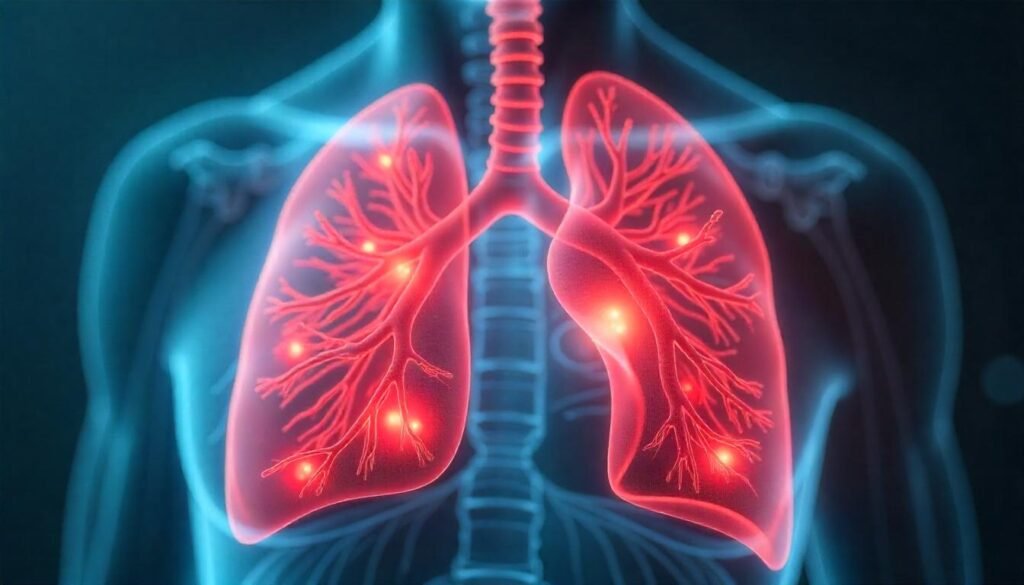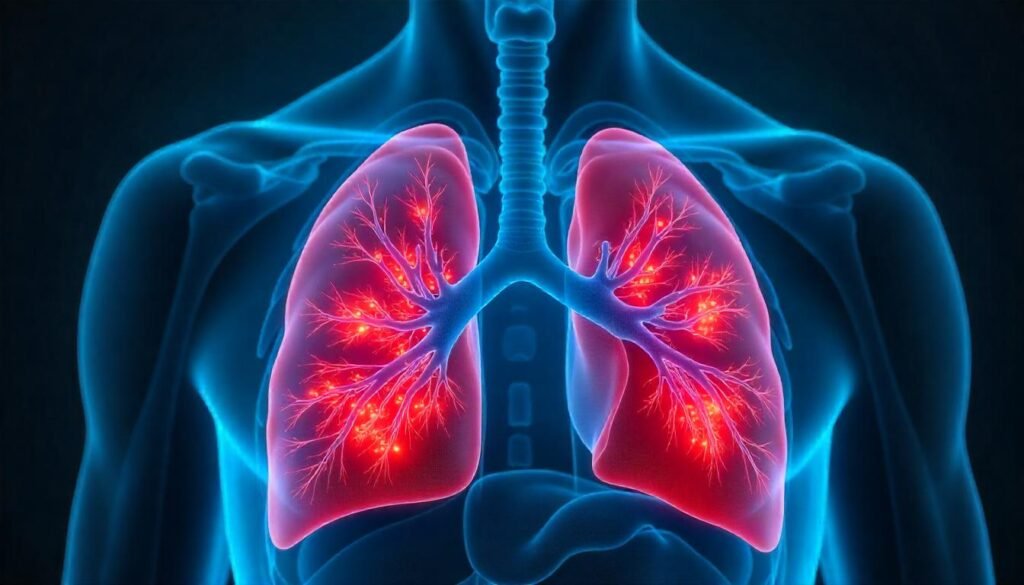Today we will discuss types of pneumonia and their causes in humans. Pneumonia, an infection that inflames the air sacs in one or both lungs, is a common yet potentially serious condition that affects millions of people worldwide. While most individuals associate pneumonia with common symptoms like cough, fever, and difficulty breathing, the reality is much more nuanced. In this comprehensive article, we’ll explore the different types of pneumonia, including those that specifically affect adults, the elderly, and children. We will also delve into the various causes of pneumonia, providing a clear understanding of this multifaceted disease.
Table of Contents

What is Pneumonia?
Pneumonia can be caused by a variety of microorganisms, including bacteria, viruses, and fungi. The severity of pneumonia can range from mild to life-threatening, depending largely on factors such as age, overall health, and the specific type of pneumonia contracted. Understanding the various forms of this illness is crucial for effective prevention and treatment.
Types of Pneumonia in Adults
Pneumonia, an inflammatory condition affecting the lungs, can manifest in various forms in adult individuals. These different types of pneumonia each possess their own distinct set of characteristics and are triggered by a variety of causative agents. Understanding the nuances of these different forms is crucial for appropriate diagnosis and effective treatment strategies.
Therefore, let us proceed to delve into an examination of some of the more commonly encountered and prevalent forms of pneumonia that affect adults. We will explore these widespread types of pneumonia of the illness, looking into what makes each one unique and how they typically present themselves in patients. By focusing on these common occurrences, we hope to give a clearer view of pneumonia in general.
1. Community-Acquired Pneumonia (CAP)
This type is commonly contracted outside of healthcare settings, and it usually stems from bacterial or viral infections. The most common bacteria responsible for CAP include Streptococcus pneumoniae, and the viral agents may include influenza viruses. Symptoms can manifest suddenly and may include chest pain, cough, fatigue, and fever.

2. Hospital-Acquired Pneumonia (HAP)
Developing in a healthcare setting, HAP is often more severe than CAP due to the virulent pathogens present in hospitals, which can include resistant bacteria like Methicillin-resistant Staphylococcus aureus (MRSA). HAP typically affects individuals who are already ill or have prolonged hospital stays.
3. Aspiration Pneumonia
This type occurs when foreign materials, such as food or liquid, enter the lungs. It is critical to note that aspiration pneumonia is prevalent among individuals with swallowing difficulties or impaired consciousness. Symptoms may include cough, fever, and difficulty breathing, which can develop gradually or suddenly.
4. Viral Pneumonia
Caused primarily by viruses like influenza or respiratory syncytial virus (RSV), viral pneumonia tends to be less severe than bacterial pneumonia but can still lead to significant complications, especially in vulnerable populations.
Rare Types of Pneumonia
While common types of pneumonia can often be easily identified, there are rarer forms that require a specialized understanding:
5. Fungal Pneumonia
This is an infection caused by fungi, which may be inhaled from the environment. Histoplasmosis and coccidioidomycosis are examples of fungal pneumonia. Those with weakened immune systems are at particular risk for developing this type.
6. Chemical Pneumonia
Exposure to toxic substances can result in chemical pneumonia. The lung tissue reacts adversely to these chemicals, causing inflammation and infection. Exposure can occur in workplaces with hazardous materials or from accidental inhalation of household chemicals.

Types of Pneumonia in the Elderly
The elderly population is particularly susceptible to pneumonia due to physiological changes and Comorbidities. Understanding the specific types of pneumonia, these individuals can develop is critical:
7. Elderly Community-Acquired Pneumonia
Similar to CAP seen in younger adults, elderly patients often encounter pneumonia caused by common pathogens. However, age-related decline in immune function means that this condition can escalate rapidly if not treated promptly.
8. Ventilator-Associated Pneumonia (VAP)
Patients requiring mechanical ventilation while hospitalized face a considerably elevated chance of developing ventilator-associated pneumonia, often referred to as VAP. This serious pulmonary condition poses a significant threat to individuals already vulnerable due to their underlying health issues.
The development of VAP can stem from several factors, with two primary routes of infection being aspiration and the introduction of harmful pathogens directly through the mechanical ventilation equipment itself. Aspiration occurs when fluids or substances from the upper respiratory tract or stomach are inadvertently inhaled into the lungs, creating a breeding ground for bacteria.
Alternatively, the ventilator tubing and related components can become contaminated with pathogenic microorganisms, which are then propelled into the patient’s lungs during the ventilation process, ultimately leading to infection and the manifestation of VAP.
Types of Pneumonia in Children
Pneumonia, a serious respiratory infection, poses a threat not just to adults but also to children of all ages. Youngsters are unfortunately vulnerable and can contract different types of pneumonia. Given this susceptibility, it is crucial that parents and guardians remain observant and alert. The health and well-being of children depend on early detection, making it paramount that parents stay vigilant. Therefore, caregivers should be particularly watchful for any signs or indicators that might suggest the presence of pneumonia. Recognizing these potential symptoms promptly is essential for ensuring timely medical intervention and the best possible outcome for their child’s health.
9. Pneumonia in Infants
Due to their immature immune systems, infants face a heightened susceptibility to illness, and in particular, they are more vulnerable to developing pneumonia. Pneumonia itself can be caused by a variety of pathogens, originating from either viral or bacterial infections. Because the cause of pneumonia can vary, it’s important to remain vigilant. If an infant or child experiences symptoms resembling a common cold, such as a cough or runny nose, and these symptoms progressively worsen or fail to improve as expected, this should be a cause for concern. In such cases, seeking professional medical advice through a consultation with a doctor or other qualified healthcare provider is strongly recommended to properly assess the situation.
10. Bacterial Pneumonia in School-aged Children
Bacterial pneumonia is a condition that frequently presents itself in children of school age. A common precursor to the development of bacterial pneumonia in this age group is a recent or ongoing respiratory infection. When a child of school age exhibits symptoms such as a significantly elevated fever and a cough that does not subside, it is important to seek professional medical attention. The persistence of the cough, combined with a high temperature, suggests the possibility of a more serious underlying infection. Therefore, parents and caregivers should promptly consult a healthcare provider to determine the cause of the symptoms and initiate appropriate treatment if bacterial pneumonia is suspected.
Causes of Pneumonia
Understanding the causes of pneumonia is vital for effective prevention:
- Bacterial Infections: In many instances of pneumonia, the underlying cause is a bacterial infection. A wide array of bacteria can trigger this respiratory illness, leading to inflammation and fluid accumulation in the lungs. However, certain specific bacterial strains are more frequently implicated than others in pneumonia diagnoses, standing out as particularly common culprits. Among these, Streptococcus pneumoniae is a well-known example. This particular bacterium is especially notorious for its role in causing pneumonia, frequently identified as the responsible agent in numerous cases of the disease.
- Viral Infections and Pneumonia: Pneumonia, an inflammation of the lungs, can frequently stem from viral infections. In these instances, viruses are the causative agents behind this respiratory illness. A prime example of a virus known to induce pneumonia is the influenza virus. Indeed, influenza is recognized as one of the most prevalent viral causes associated with the development of pneumonia in individuals.
- Various environmental factors can play a significant role in impacting lung health. Specifically, the presence of pollutants in the air, such as particulate matter and noxious gases, can irritate the delicate tissues of the lungs, leading to inflammation. Similarly, allergens, like pollen, dust mites, and pet dander, can trigger allergic reactions that manifest as lung inflammation and increased sensitivity. Furthermore, exposure to secondhand smoke, which contains a complex mixture of harmful chemicals, is a well-known irritant that can significantly contribute to inflammation within the respiratory system, consequently making individuals much more vulnerable to respiratory illnesses and other lung-related problems. This heightened inflammation leaves those exposed more susceptible to developing various lung conditions.
- A compromised or weakened immune system significantly elevates an individual’s susceptibility to various infections. This impairment of immune function can arise from a number of underlying health conditions. For instance, infections such as HIV/AIDS directly attack and dismantle the immune system, leaving the body vulnerable. Similarly, cancer, particularly when undergoing treatments like chemotherapy, can severely suppress immune responses, thereby increasing the likelihood of opportunistic infections taking hold. Furthermore, various chronic diseases, due to their long-term effects and potential impact on immune cell development and function, can also contribute to a weakened immune system and a heightened vulnerability to infectious agents.
Conclusion
In summary, pneumonia is a complex condition with various types of pneumonia that affect diverse populations in unique ways. Awareness of the different forms, especially among adults, the elderly, and children, is essential for prompt diagnosis and effective treatment. By understanding the causes and contributing factors of pneumonia, we can promote better health outcomes through education and preventative measures.
Frequently Asked Questions (FAQs)
1. What are the common symptoms of pneumonia?
Frequently experienced symptoms encompass a persistent cough, often accompanied by a significantly elevated fever. Individuals may also encounter difficulty breathing, a troubling symptom that can make respiration labored and strained. In addition to these, chest pain is a common complaint, sometimes described as a sharp or dull ache. Furthermore, pronounced fatigue, characterized by overwhelming tiredness and a lack of energy, is another symptom frequently reported by those affected.
2. How can I prevent pneumonia?
To proactively safeguard your health, there are several key steps you can take. First and foremost, vaccination is a crucial preventative measure against various infectious diseases. Furthermore, practicing good hygiene, such as frequent handwashing and proper sanitation, significantly reduces the risk of illness. Avoiding smoking, a known contributor to numerous health problems, is also highly recommended. Finally, maintaining a healthy lifestyle, which encompasses a balanced diet, regular exercise, and sufficient sleep, is essential for overall well-being and disease prevention.
3. Is pneumonia contagious?
Pneumonia is a respiratory illness that can arise from various causes, and the method of transmission differs depending on the specific type of pneumonia in question. Some forms of pneumonia are indeed capable of spreading from one person to another through direct or indirect contact with respiratory droplets. However, it’s important to understand that not all pneumonias share this characteristic of being contagious. Specifically, certain categories of pneumonia, most notably those that are triggered by bacterial or fungal infections rather than viruses, typically do not spread easily between individuals, and are therefore not considered contagious.
4. When should I see a doctor?
It is important to consult with a healthcare professional without delay if you find yourself suffering from a cough that lingers for an extended period of time. Furthermore, seeking medical help is advisable if you are experiencing any trouble with your breathing or if you observe that your symptoms are progressively becoming more severe. This is particularly crucial if you are part of a group known to be more susceptible to complications. Pay close attention to your body, and remember that a persistent cough, breathing difficulties, or a general worsening of your condition warrants immediate medical evaluation, particularly if you fall within a population considered to be at higher risk.
5. Are there treatments available for pneumonia?
Effective treatments for pneumonia vary significantly depending on the underlying cause, which can range from bacterial infections to viral infections. In the case of bacterial pneumonia, antibiotics are typically prescribed to combat the bacteria and facilitate recovery. Conversely, when pneumonia is caused by a virus, the treatment approach often focuses on supportive care measures, aimed at alleviating symptoms and allowing the body’s natural defenses to fight off the infection. It is of utmost importance to seek guidance from a qualified healthcare professional. They can accurately diagnose the specific type of pneumonia and recommend the most appropriate and personalized treatment plan based on your individual needs and circumstances.
By exploring and understanding the complexities of pneumonia, we equip ourselves with the knowledge needed to address this pervasive health challenge effectively. Remember, early detection and proactive measures are key to successful prevention and treatment.


